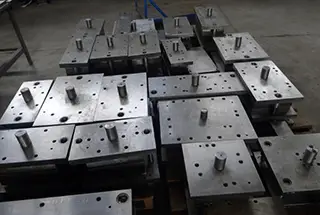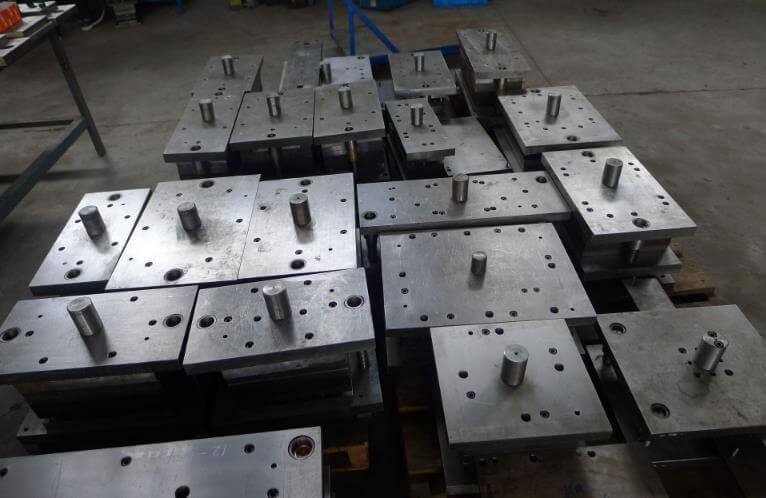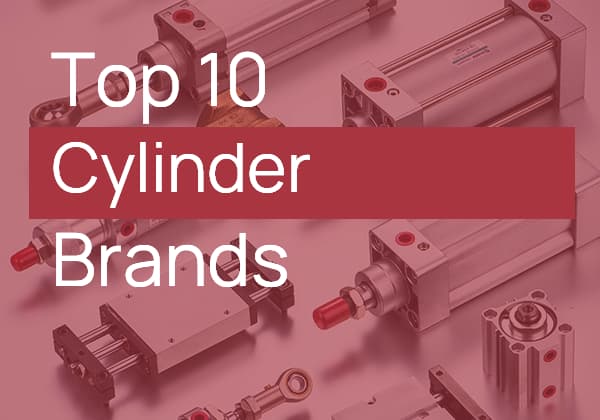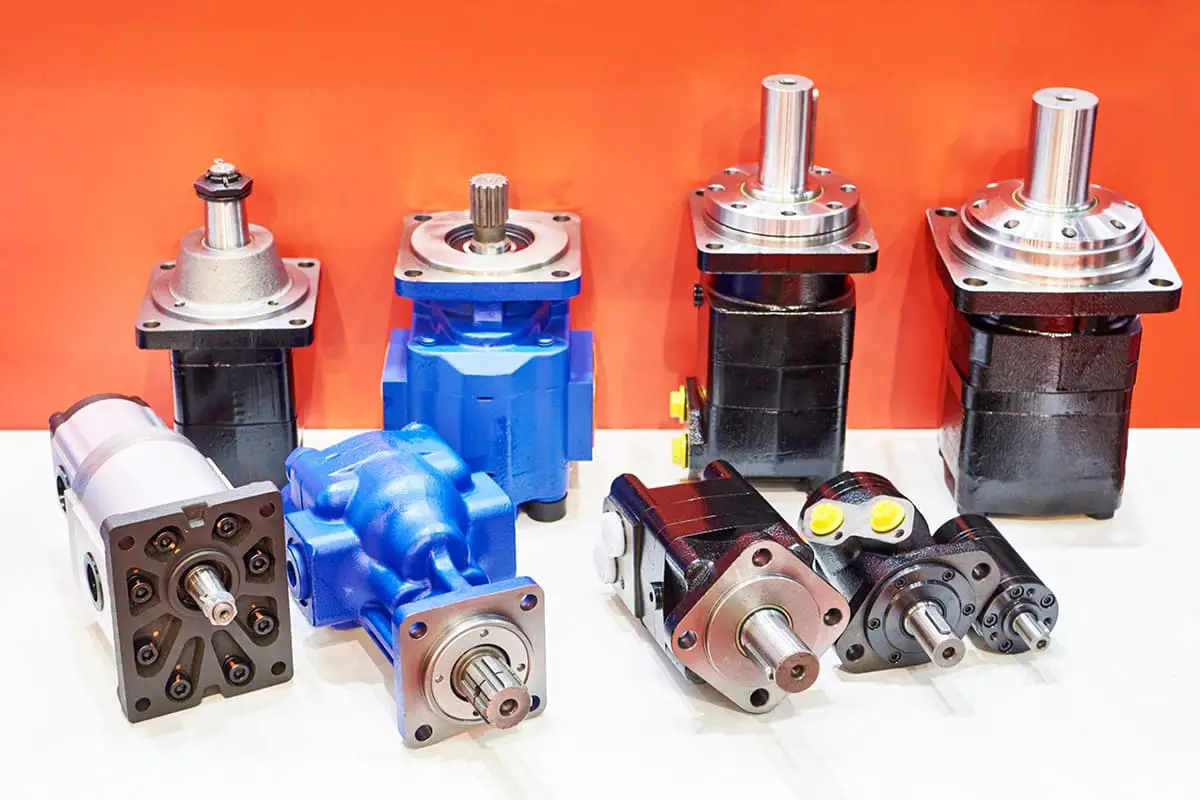
Have you ever wondered what makes the intricate molds used in everyday objects so precise and durable? This article explores the 24 most frequently used metal materials in mold processing. From carbon steels to stainless steels, discover the unique properties and applications of each material. Get ready to uncover the secrets behind the metals that shape our world!

There are over 100 types of materials that can be used for mold processing, including metals, plastics, inorganic non-metals, and wax.
Related reading: Type of metal
However, each material has its own specific purpose and requirements based on actual needs.
Today, let’s discuss the 24 most frequently used metal materials in mold processing.

Key Features:
AISI 1045 (equivalent to #45 in some standards) is a versatile medium carbon steel widely utilized in the manufacturing industry. This grade offers an excellent balance of strength, toughness, and wear resistance when properly heat-treated. Its carbon content (typically 0.42-0.50%) allows for significant hardening through quenching and tempering, resulting in improved mechanical properties.
However, due to its medium carbon content, #45 steel exhibits moderate hardenability, which can lead to challenges in achieving uniform hardness in larger cross-sections or when using less severe quenchants. To mitigate potential cracking issues during water quenching, especially in components with complex geometries or varying thicknesses, oil quenching or polymer quenchants are often preferred.
For optimal results:
Applications:
45 steel finds extensive use in manufacturing critical load-bearing and moving parts that demand high strength and good wear resistance. Common applications include:
When welding #45 steel, proper precautions are essential:
By adhering to these guidelines, manufacturers can fully leverage the capabilities of #45 steel while mitigating potential fabrication challenges.
Key Features:
Q235A, also known as A3 steel, is a low-carbon structural steel that offers an excellent balance of properties and cost-effectiveness. This material exhibits high plasticity and toughness, superior weldability, excellent cold stamping capability, moderate strength (with a yield strength of approximately 235 MPa), and good cold bending performance. Its carbon content typically ranges from 0.14% to 0.22%, contributing to its versatility in various manufacturing processes.
Applications:
Q235A is widely utilized in components and welded structures with general load-bearing requirements. Its combination of properties makes it suitable for a diverse range of applications, including:
The material’s good formability allows for efficient manufacturing processes such as bending, stamping, and welding, making it a popular choice for both large-scale structural applications and smaller, intricate components. Its moderate strength and high ductility provide a good safety factor in designs where sudden failure must be avoided.
When selecting Q235A for specific applications, engineers should consider factors such as load requirements, environmental conditions, and potential for fatigue or impact loading. While Q235A offers excellent general-purpose performance, higher-strength steels may be necessary for more demanding applications.
Key Features:
40Cr is characterized by its excellent balance of mechanical properties, including notable low-temperature impact toughness and reduced notch sensitivity following quenching and tempering treatments. Its superior hardenability allows for high fatigue strength when oil-cooled, though complex geometries may be susceptible to cracking if water-cooled.
The material exhibits moderate cold bending plasticity and favorable machinability in tempered or quenched and tempered states. However, its poor weldability necessitates preheating to 100-150°C to mitigate cracking risks during welding processes. 40Cr is typically utilized in the quenched and tempered condition, with additional surface treatment options including carbonitriding and high-frequency surface quenching for enhanced performance characteristics.
Applications:
This versatile alloy’s ability to undergo various heat treatments and surface modifications makes it an ideal choice for a wide range of engineering applications, particularly where a combination of strength, wear resistance, and toughness is required.
Applications:
HT150, a grade of grey cast iron, finds extensive use in industrial and automotive applications due to its excellent castability, machinability, and vibration-damping properties. This versatile material is commonly employed in the manufacturing of:
The material’s high thermal conductivity makes it suitable for components exposed to temperature fluctuations, while its self-lubricating properties from graphite flakes enhance its performance in applications with sliding surfaces. When designing with HT150, engineers must consider its relatively low tensile strength compared to steel, but can take advantage of its cost-effectiveness and excellent castability for large, complex parts.
Key Features:
This medium carbon steel grade exhibits a well-balanced combination of strength and ductility, making it versatile for various manufacturing processes. Its notable characteristics include:
Applications:
This material is widely utilized in the production of critical components that demand a combination of strength, toughness, and fatigue resistance:
The material’s ability to withstand high cyclic loads, coupled with its good machinability and heat treatment response, makes it an excellent choice for components that require reliable performance under demanding conditions. Its widespread availability and well-established processing techniques contribute to its popularity in manufacturing various standard parts and fasteners across multiple industries.
Applications:
65Mn is widely utilized in the manufacturing of diverse spring components, leveraging its excellent elasticity and fatigue resistance. This high-carbon manganese steel is particularly well-suited for small to medium-sized spring applications across various industries.
Key applications include:
65Mn’s combination of strength, ductility, and wear resistance makes it an ideal choice for applications requiring high cyclic loading and consistent performance over extended periods. However, designers should consider its moderate corrosion resistance and potential for hydrogen embrittlement in certain environments.
Features:
0Cr18Ni9, also known as 18/8 stainless steel, is a versatile austenitic chromium-nickel stainless steel. Its chemical composition typically includes 18% chromium and 8-10% nickel, providing excellent corrosion resistance, formability, and mechanical properties. This grade offers:
Applications:
Due to its outstanding combination of properties, 0Cr18Ni9 finds extensive use in diverse industries:
Its versatility, coupled with its excellent corrosion resistance and formability, makes 0Cr18Ni9 the go-to choice for a wide range of applications requiring a balance of performance, durability, and cost-effectiveness.
Features:
Cr12 steel is a high-carbon, high-chromium ledeburitic tool steel widely utilized in cold working applications. Its chemical composition typically includes 1.9-2.2% C and 11-13% Cr, resulting in excellent hardenability and superior wear resistance. The high chromium content forms complex carbides, enhancing the steel’s resistance to abrasive and adhesive wear. Cr12 exhibits good dimensional stability during heat treatment, maintaining its shape and size with minimal distortion.
Applications:
Despite its outstanding wear resistance, Cr12 steel’s high carbon content (approximately 2%) leads to relatively low impact toughness and increased susceptibility to brittle fracture. The formation of large, unevenly distributed eutectic carbides can further compromise its toughness. However, these limitations are often outweighed by its exceptional wear resistance in many cold working applications.
Cr12 steel finds extensive use in the manufacture of:
To optimize performance, Cr12 steel typically undergoes a carefully controlled heat treatment process, including austenitizing at 920-980°C, oil quenching, and tempering at 180-220°C to achieve a hardness of 58-62 HRC. For applications requiring improved toughness, advanced heat treatment techniques such as deep cryogenic treatment or multiple tempering cycles may be employed.
When selecting Cr12 steel for specific applications, engineers must carefully consider the balance between wear resistance and toughness requirements, often exploring surface treatments or alternative tool steel grades for components subject to high impact loads.
Features:
DC53 is a high-performance cold work die steel developed by Daido Steel, a renowned specialty steel manufacturer in Japan. This advanced material exhibits an exceptional combination of high strength, superior toughness, and excellent dimensional stability. After undergoing a specialized high-temperature tempering process, DC53 achieves remarkable characteristics:
The unique alloy composition of DC53, which includes optimized levels of chromium, molybdenum, and vanadium, contributes to its outstanding performance in demanding cold work applications.
Applications:
DC53 has gained widespread adoption in precision cold working operations, where tool life and dimensional accuracy are critical. Common applications include:
The exceptional properties of DC53 make it particularly suitable for high-volume production runs, where tool longevity and consistent part quality are essential for operational efficiency and cost-effectiveness.
Dccr12mov is an advanced wear-resistant chromium steel that offers superior performance characteristics compared to traditional Cr12 steel. This domestic variant features a lower carbon content and enhanced carbide uniformity through the strategic addition of Molybdenum (Mo) and Vanadium (V). Mo effectively reduces carbide segregation and improves hardenability, while V refines the grain structure and significantly boosts toughness.
This steel grade exhibits exceptional hardenability, allowing for full quenching in sections up to 400mm thick. It maintains excellent hardness and wear resistance at elevated temperatures of 300 to 400°C, outperforming many conventional tool steels. The improved toughness compared to Cr12 steel, coupled with minimal volume change during heat treatment, ensures dimensional stability in complex tooling applications.
Key properties of Dccr12mov include:
These characteristics make Dccr12mov an ideal material for manufacturing a wide range of high-performance tooling, including:
The versatility and durability of Dccr12mov make it a preferred choice for applications requiring extended tool life, tight tolerances, and resistance to demanding operating conditions in modern manufacturing environments.
SKD11, also known as D2 in the AISI standard, is a high-carbon, high-chromium tool steel renowned for its exceptional wear resistance and dimensional stability. Developed in Japan, the Hitachi variant of SKD11 represents a significant advancement in steel production technology. This improved version features a refined microstructure characterized by:
These metallurgical improvements result in a superior balance of mechanical properties compared to conventional Cr12MoV (D2) steel:
Consequently, dies and tools manufactured from SKD11 Hitachi type steel demonstrate extended service life, particularly in applications involving:
The superior performance of SKD11 Hitachi type steel translates to reduced downtime, lower tooling costs, and improved part quality in metal forming and cutting operations.
D2 steel, originally developed in the United States, is a premium air-hardening tool steel widely recognized for its exceptional properties. This high-alloy steel is characterized by its high carbon (typically 1.4-1.6%) and high chromium (11-13%) content, which contributes to its outstanding performance in cold working applications.
Key attributes of D2 steel include:
Heat Treatment Considerations:
D2 steel excels in the manufacture of:
While D2 offers numerous advantages, users should be aware of its relatively high cost and the need for proper heat treatment to achieve optimal properties. Additionally, its machinability in the annealed state is challenging, often requiring grinding operations for final shaping.
SKD11, also known as SLD, is a high-performance tool steel developed and produced by Hitachi Metals in Japan. This advanced steel grade is characterized by its exceptional combination of wear resistance, toughness, and dimensional stability.
The unique composition of SKD11 features increased amounts of molybdenum (Mo) and vanadium (V), which significantly enhance the steel’s microstructure. These alloying elements promote a refined grain structure and improve carbide morphology, resulting in superior mechanical properties compared to conventional tool steels like SKD1 and D2.
Key advantages of SKD11 include:
SKD11 is widely utilized in high-demand applications, particularly in the manufacturing of:
The superior properties of SKD11 make it an ideal choice for applications requiring extended tool life, tight tolerances, and resistance to challenging working conditions.
DC53 is a premium-grade cold work tool steel developed by Daido Steel in Japan, specifically engineered for high-performance die applications.
This advanced alloy exhibits superior hardness characteristics post-heat treatment compared to conventional SKD11 (AISI D2) steel. Through optimized high-temperature tempering processes, DC53 can achieve an impressive hardness range of 62-63 HRC, surpassing the typical hardness levels of SKD11.
DC53’s unique composition and heat treatment result in a remarkable combination of strength, wear resistance, and toughness. Notably, its impact toughness is approximately twice that of SKD11, significantly enhancing its resistance to brittle fracture under high stress conditions.
The exceptional toughness of DC53 translates to superior crack resistance and dimensional stability during cold work die manufacturing and operation. This characteristic substantially extends the service life of dies and tools, reducing downtime and replacement costs in industrial applications.
A key advantage of DC53 is its low residual stress profile, which is further minimized after high-temperature tempering. This property contributes to enhanced dimensional stability and reduced risk of warpage during machining and in-service use.
DC53 demonstrates superior machinability and electrical discharge machining (EDM) characteristics compared to SKD11. The reduced tendency for cracking and deformation during wire EDM processes allows for more precise and efficient manufacturing of complex die shapes.
Common applications for DC53 include high-precision stamping dies, cold forging dies, and deep drawing dies, particularly in industries requiring tight tolerances and extended tool life. Its balanced properties make it especially suitable for large section dies and those subjected to high impact loads.
SKH-9, developed and produced by Hitachi Metals in Japan, is a high-performance high-speed steel (HSS) renowned for its exceptional combination of wear resistance, toughness, and strength. This versatile tool steel is widely employed in the manufacturing of critical industrial components, particularly those subject to high stress and wear conditions.
Key applications for SKH-9 include:
The superior properties of SKH-9 are attributed to its carefully balanced chemical composition and optimized heat treatment process. Typical alloying elements include tungsten, molybdenum, vanadium, and cobalt, which contribute to the formation of hard carbides and a stable martensitic matrix.
Compared to conventional high-speed steels, SKH-9 offers:
These characteristics make SKH-9 an ideal choice for applications requiring long tool life, consistent performance, and the ability to machine difficult materials. While it may have a higher initial cost compared to some standard HSS grades, the extended service life and improved productivity often result in a lower overall cost per part produced.
ASP 23 is a premium powder metallurgy high-speed steel developed and manufactured in Sweden. This advanced material is renowned for its exceptional microstructure, characterized by a uniform and fine carbide distribution. This unique structure results from the powder metallurgy process, which involves atomizing molten steel into fine powder particles and then consolidating them under high pressure and temperature.
Key attributes of ASP 23 include:
ASP 23 finds extensive application in high-performance cutting tools, particularly those requiring extended service life under demanding conditions. Common applications include:
The combination of wear resistance, toughness, and thermal stability makes ASP 23 an ideal choice for tools operating in both intermittent and continuous cutting scenarios, especially when processing abrasive or difficult-to-machine materials.
P20 is a versatile pre-hardened mold steel widely used in the plastic injection molding industry for general-purpose applications. This steel grade offers an excellent balance of machinability, polishability, and wear resistance. It can be readily processed using both conventional machining methods and electrical discharge machining (EDM). In its pre-hardened condition, P20 typically exhibits a hardness range of 30-34 HRC (approximately 285-320 HB), eliminating the need for additional heat treatment in most applications.
When higher hardness is required, P20 can be further heat-treated. After proper quenching and tempering, it can achieve hardness levels up to 50-54 HRC, enhancing its wear resistance and load-bearing capacity. This steel grade is characterized by its uniform hardness throughout the cross-section, good dimensional stability, and excellent weldability. These properties make P20 an ideal choice for large molds, prototype tooling, and low to medium production volume plastic injection molds.
P20 steel finds applications beyond plastic molds, including die-casting dies, extrusion dies, and various industrial tooling components where a combination of toughness and wear resistance is crucial. Its balanced composition, typically including chromium, molybdenum, and manganese, contributes to its superior performance in demanding molding environments.
AISI P20 modified (DIN 1.2738), a Swedish-made premium mold steel, is specifically engineered for large and small plastic molds with demanding specifications. This versatile material offers exceptional machinability through electrical discharge machining (EDM) techniques. It is supplied in a pre-hardened condition, exhibiting a hardness range of 290 to 330 HB (Brinell). When additional wear resistance is required, it can be through-hardened to achieve 52 HRC (Rockwell C).
Key features of this mold steel include:
These properties make 718 an ideal choice for complex, high-performance injection molds, compression molds, and blow molds in the plastics industry, particularly for automotive, consumer electronics, and medical device applications.
Daido Steel Co., Ltd. in Japan produces Nak80, a pre-hardened mold steel renowned for its exceptional properties in high-precision plastic molding applications. This premium grade steel exhibits a supply hardness of 37-40 HRC (approximately 370-400 HB) and can be further heat-treated to achieve a hardness of up to 52 HRC.
Nak80 is specifically engineered to meet the demanding requirements of high-mirror finish and high-precision plastic molds. Its key characteristics include:
These properties make Nak80 particularly suitable for molds used in the production of high-quality plastic components for industries such as automotive (e.g., headlight lenses), consumer electronics (e.g., smartphone casings), and medical devices (e.g., precision components).
When working with Nak80, mold makers should consider its specific heat treatment recommendations and optimal machining parameters to fully leverage its superior characteristics and achieve the best results in high-precision plastic molding applications.
S136, also known as AISI 420 or DIN 1.2083, is a premium grade stainless mold steel produced in Sweden. This material offers an exceptional combination of properties that make it ideal for high-performance plastic mold applications:
Typical applications include molds for corrosive plastics, medical components, optical lenses, and parts requiring high surface quality or food-grade compliance. The material’s versatility makes it suitable for both injection molding and blow molding processes.
H13 tool steel is widely utilized in high-temperature, high-stress applications, particularly in die casting and related processes. Its unique combination of properties makes it ideal for:
Key characteristics that make H13 suitable for these applications include:
Typical heat treatment for H13 in die casting applications involves austenitizing at 1000-1040°C (1830-1900°F), followed by air or oil quenching, and tempering at 550-650°C (1020-1200°F) to achieve a working hardness of 44-52 HRC.
For optimal performance, H13 dies often undergo surface treatments such as nitriding or PVD coating to further enhance wear resistance and extend tool life.
SKD61, a premium hot work tool steel produced by Hitachi Metals in Japan, is manufactured using advanced electroslag remelting (ESR) technology. This sophisticated process significantly enhances the steel’s microstructure, resulting in superior performance characteristics compared to conventional H13 steel. The ESR method ensures exceptional cleanliness, homogeneity, and isotropic properties throughout the material.
Key advantages of SKD61 include:
These properties make SKD61 particularly well-suited for:
When properly heat-treated and surface-engineered (e.g., with PVD coatings), SKD61 can significantly reduce downtime, increase productivity, and improve part quality in high-volume manufacturing processes.
Made in Sweden, the 8407 tool steel is a premium-grade material specifically engineered for high-performance die casting applications, particularly excelling in hot stamping dies and aluminum extrusion dies. This steel grade offers an exceptional combination of properties that make it ideal for these demanding processes:
Typical applications for 8407 tool steel in die casting include complex automotive components, structural aerospace parts, and high-precision extrusion profiles. When properly heat-treated and maintained, dies made from this material can significantly enhance productivity, part quality, and overall process economics in advanced die casting operations.
FDAC (Fine Die Air Cooling) steel is a specialized pre-hardened mold steel with sulfur added to enhance its machinability. This material exhibits a pre-hardening hardness range of 38-42 HRC, allowing direct machining without the need for additional heat treatment processes such as quenching and tempering. The sulfur addition promotes the formation of manganese sulfide (MnS) inclusions, which act as internal chip breakers during machining operations, resulting in improved chip formation and evacuation.
This high-performance steel is particularly well-suited for applications requiring rapid production and cost-effective manufacturing. It finds extensive use in small-batch production molds, geometrically simple molds, and various resin product tooling. Additionally, FDAC is an excellent choice for sliding components and mold parts that demand quick turnaround times. Common applications include:
The combination of moderate hardness and enhanced machinability makes FDAC an ideal material for achieving high-quality surface finishes and tight tolerances in mold making, while simultaneously reducing tool wear and machining cycle times. This unique balance of properties contributes to overall cost reduction and improved productivity in mold manufacturing processes.








